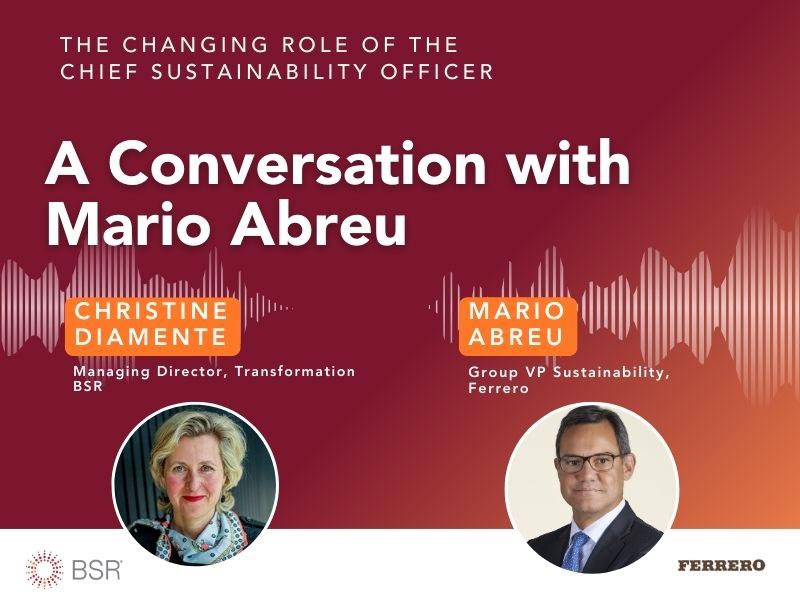
Authors
-
Martin Lemos
Former Manager, BSR
With an average of one in 10 S&P 500 companies experiencing a CEO transition each year, sustainability departments need to be prepared to effectively manage a change in company leadership.
As we articulated in our recent report, Redefining Sustainable Business: Management for a Rapidly Changing World, the era of stand-alone sustainability strategies, with subsequent integration of sustainability into company strategy, needs to end; the creation of resilient business strategies that take sustainability as their foundation needs to begin. An important test of a company’s resilience is how it weathers a CEO transition.
In most cases there is sufficient time to adjust—S&P analysis also shows that nearly 80 percent of CEO transitions are the result of long-standing succession plans. But in the case of forced or pressured resignations and mergers, changes can be abrupt and messy and require departments to balance preparing for a new CEO while simultaneously putting out the fires of reputational and cultural crises. The increasing influence of activist investors is contributing to more frequent CEO transitions, and comparatively “poor performing companies” have a 60 percent greater likelihood of seeing a new CEO in any given year.
Even if planned, a CEO transition is disruptive, and being prepared for transition can help make the work of a sustainability department sustainable. There is little doubt that a change at the top can be a nerve-wracking time for sustainability teams: In our 2017 State of Sustainable Business Survey, more than 90 percent of sustainability practitioners identified CEOs as the key influence on their companies’ sustainability agendas—more than employees, investors, or even customers. Losing a senior advocate is a tremendous risk, especially for organizations losing vocal and influential leaders who’ve shaped their corporate sustainability programs.
Part of proactively managing for CEO transition is deeply embedding and integrating sustainability. Making your programs essential to your company’s value creation and standard risk management processes will ensure that efforts are maintained despite the inevitable changes that come with new leadership. Setting long-term public goals is not just good practice—it can help keep the company accountable to those objectives, even through leadership changes.
When a CEO transition happens, however, sustainability teams need to mobilize. With a new audience likely comes the need for a refreshed business case. And while this change could threaten long-standing programs that may be closely associated with a previous CEO’s legacy, a leadership change may also offer sustainability teams a new opportunity to better integrate sustainability into the core business strategy. The task of the sustainability department in these initial months is to begin to build a relationship with your new company leader and provide a succinct narrative for sustainability as value creation.
Boiling down years of efforts and programs is no easy task, but answering a few guiding questions should help you hone and sharpen your pitch for maintained or increased investment.
- Why was there a transition? Understanding the nature of a CEO transition is critical. In cases where a CEO had long-planned retirement or was enticed by a “new opportunity,” this may be less significant. For more seismic transitions, however, sustainability departments need to pay attention: Was the change precipitated by poor market performance, activist investors, reputational impacts from unethical business practices, or a highly publicized toxic culture? These factors represent failures that a new CEO will be mandated to remediate, and your sustainability department would be wise to explore how you could help mitigate those specific risks in the future.
- What is the new CEO’s view of sustainability? When a new CEO is selected, it is useful to review his or her past experience: How mature were the sustainability programs in their previous companies? Are there key themes in their previous CEO letters that can help anticipate how they view sustainability? A new leader’s perspective on sustainability may not be clear until your first meeting, but awareness of his or her interests and past efforts can help inform your presentation.
- What’s the current sustainability strategy—and is it actually current? A change in leadership offers an opportune moment to take stock of your current sustainability strategy. A rapid but robust strategy discussion can be extremely helpful to prepare your team for your first CEO conversation. What are your company’s material issues, and does the CEO change signal a shift in priorities? What has the company’s ambition level on these material issues been to date, and is there a corresponding need to advance your programs on these issues? The CEO transition should offer a moment to evaluate, refresh, and align your company strategy and your sustainability strategy.
- What has sustainability achieved, where has it failed, and what’s on the horizon? All departments will, to some extent, be required to justify their programs and resources. While an exaggerated litany of achievements may be impressive, a clear-eyed account of achievements and shortcomings may be more effective at creating a strong advocate in the CEO’s office. Highlighting key milestones and demonstrating cross-functional support will show the sustainability department as an effective force for integration within the organization. An honest account of challenges and constraints creates trust that is integral to a strong working relationship. Positioning sustainability as a way to anticipate and respond to emerging trends shows how the team can be a critical partner in driving the company’s new strategic, resilient direction.
Ultimately, answering these questions will arm you and your team to answer the big question: How does sustainability add value to your company? To use a CEO transition to your advantage, you must be able to show that sustainability is not a remnant of an old regime, but a vital part of a company that is forging ahead. Showing how sustainability fits into the new order—whether in reaching new markets, driving innovation, or mitigating new risks—will be critical to gaining the buy-in of your new leadership.
BSR’s latest sustainability insights and events straight to your inbox.
Topics
Let’s talk about how BSR can help you to transform your business and achieve your sustainability goals.







